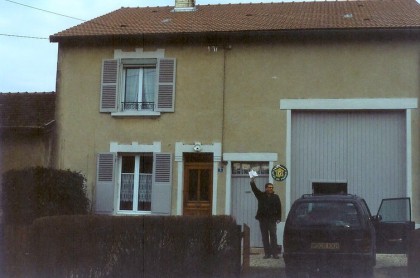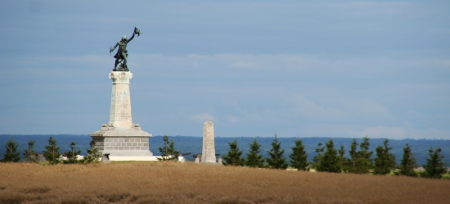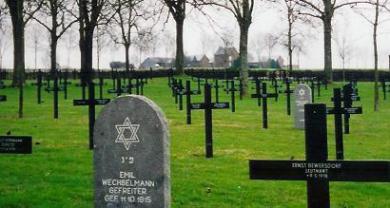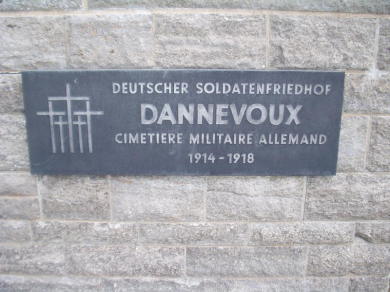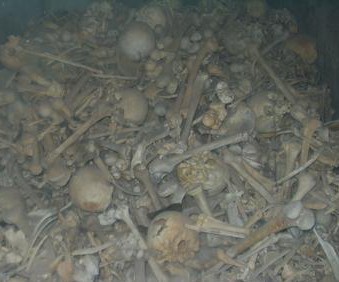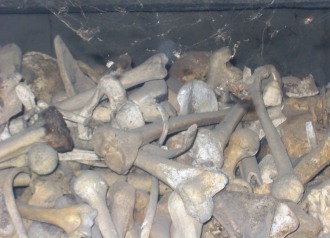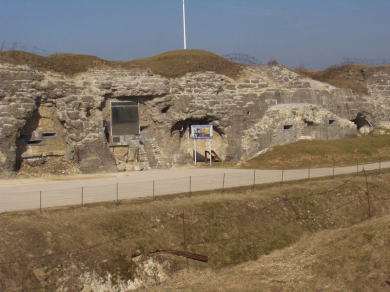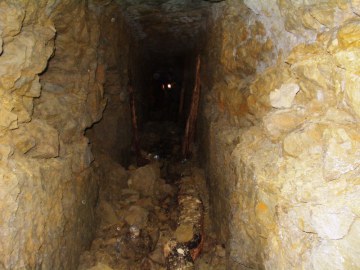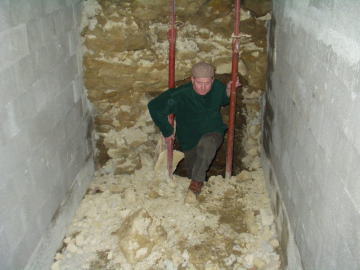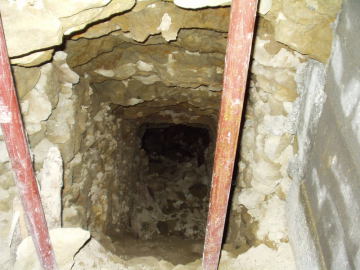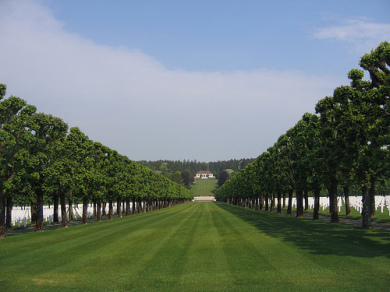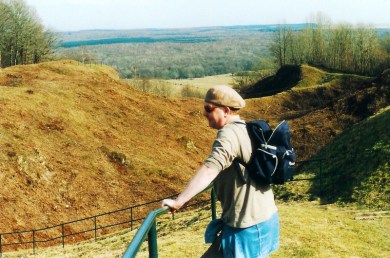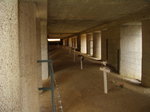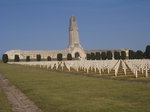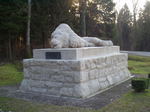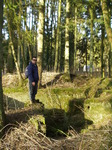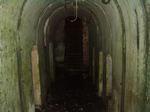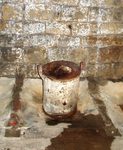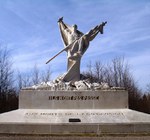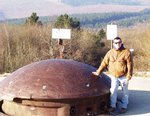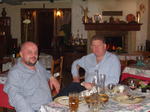
Verdun 2003
Verdun was a unique trip in many ways. It was the first time we had visited a Battlefield where none of the combatants weren't British or Commonwealth Soldiers. The
Battle was a pure Franco-German battle.
It was the smallest NMBS outing, to date (although 2014 will equal this) with just Lance, Gerry and myself (Andy McVeety had left the NMBS earlier in the year). It was not until later in the
year that Kevin Hunt and Stuart Erskine joined.
Verdun was also the first time that the NMBS had used a "Gîte" (a French Farmhouse you can hire - which NMBS recommend
that you do - excellent value for money, if you shop around) The term Gîte
originally meant quite simply a form of shelter. Gîtes today vary from being luxury holiday homes to very basic
apartments. Some Gîtes don't provide linen as standard; so you need to ask.
Gîtes are encouraged by the local tourist board and planning authorities as they attract investment and tourism.
All Gîte owners are required to ensure that their Gîtes are safe and comply with the necessary rules, regulations and insurance requirements. And to be honest we have used Gîtes in Verdun, St.
Mihiel, Normandy, The Somme, Cambrai and Ypres and never had an issue. We have hired similar in Belgium and The Netherlands too, and although the one in The Netherlands was smaller than we
anticipated, it was more than adequate.
The Gite that we stayed at was around 10miles North of Verdun in a small
beautiful village called Dannevoux, (Gîte Chez Dede; Ref 55G449).The Gite was rustic but wonderful. The owner lived across the road from us and was very kind, although did not speak any
English.
The Gîtes have central heating and in with the one in Dannevoux we had no idea how to turn the heating up or down, even off. Bearing in mind it was the middle of February at night we sat watching TV
with the French Windows open to cool down.
By the end of the week we had run up a fuel bill that would have made E-on happy This turned out to be an extra 60 € on top of the Gîte.
So a tip if you use Gîtes - make sure you know where the thermostat is and that you know how to regulate it. And if you do not need the Central heating on, don't use it. Most Gîtes have wood/coal
fires; just on your jaunts collect some fire wood in forests and woods (obviously just deadwood and clutter and do not steal from people’s stockpiles) and use that. The Gîte was splendid and we just
loved the large bronze plate of Charles De Gaulle in the Kitchen it was so French - Viva la France!
On the way to the Gîte at
Dannevoux we stopped off for a break and a croque monsieur and an Orangina and stumbled across a battlefield by
accident.
The Battle of Valmy was the first major victory by the army of France during the Revolutionary Wars that followed the French Revolution. The action took place on 20 September 1792 as Prussian troops commanded by the
Duke of Brunswick attempted to march
on Paris. Generals François Kellermann and Charles Dumouriez stopped the advance near the
northern village of Valmy in Champagne-Ardenne.
In this early part of the Revolutionary Wars, known as the War of the First
Coalition, the new French
government was in most every way unproven, and thus the small, localized victory at
Valmy became a huge psychological victory for the Revolution at large. The battle was considered a "miraculous" event and a "decisive defeat" for the vaunted Prussian army.
After the battle, the newly assembled National Convention was emboldened enough to formally declare the end of monarchy in France and the establishment of
the First French Republic. Valmy permitted the
development of the Revolution and all its resultant ripple effects, and for that it is regarded as one of the most significant battles of all time.
With no disrespect to Andy, this trip was one of the better trips of the early stages of the NMBS. Verdun is spectacular in many ways. Sobering and awe-inspiring, but also just being 3 members on
this trip it made it more “Cosy”.
The sobering side starts close to the Gîte in Dannevoux with The Deutscher Soldatenfriedhof Dannevoux or German War Cemetery. The Cemetery contains 1402 German war graves from World War I and
after breakfast I walked the few hundred yards to the cemetery. It was a crisp February morning and although it will sound clichéd there was no birdsong, just silence.
This Cemetery was the first German Cemetery where it really struck me that there were Jewish headstones with the Star of David on. Some of the Jewish headstones had dates on up to the end of
the war in 1918, saddening that these men died for their country and 20 years later Kristallnacht would have marked the start of major persecution for their families.
The biggest shock was to come at the French National Cemetery and the Douaumont Ossuary. For me the sights that I saw at the Ossuary will stay with me forever. Inside the Cloister - with the walls
(White marbled, but the windows are stained glass red - which makes the walls seem blood red as the sunlight shines through.) of the 137 metre long cloister, with tombs - each showing the precise
area of the Battle of Verdun where the bodies were recovered.
Each small tomb also has a shield (from the area of France the regiments were) and a torch of remembrance is lit on certain ceremonial days Underneath the Ossuary are the remains of 130,000 men who
cannot be identified. If you go around the back of the Ossuary, close to the ground are some windows - look through these windows you see the skulls and bones of these men piled up. It is like
looking at the pictures of the "Killing Fields" in Cambodia under Pol Pot.
Some would say this is too much and gruesome. For me even though it was stark and to be very blunt, shocking - it does what I feel is the desired effect.
The British 'reserve' would have never allowed Douaumont to happen in the UK or say at the Ypres Menin Gate site (I can just see the Daily Mail headlines now) but I think that the French have the
right idea.
I make no apologies for the pictures of the Ossuary, below. I believe that they makes sure anyone who sees the pictures or even visits the Ossuary realises the stupidity of war, greed, hate and
anger.
Apart from the Ossuary, There are numerous places around that will take up a good few days from The Jewish Memorial to the left of the Ossuary to the Muslim Memorial and rows upon rows of graves that face Mecca to the right of the Ossuary (by the time we re-visited nearly a decade later there was a new memorial to the Muslim troops who had died).
The small woods in front of the French National cemetery is full of shell holes and Iron Harvest, so with all battlefields caution is advised.
Fort Douaumont provided another memorable site. The fort at Douaumont was the North Eastern "Pillar" of the ring around the fortress town of Verdun,
and was built between 1881 and 1884 (and with better explosives being formed in 1888, the wall were made stronger.
However, by 1915 the French General Staff had concluded that even the best-protected forts of Verdun could not resist bombardments from the German 420 mm (16 in) Gamma guns. These newly deployed giant howitzers had easily taken several large Belgian forts out of action in August 1914.
As a result, Fort Douaumont and other Verdun forts, being judged ineffective, had been partly disarmed and left virtually undefended since 1915. Consequently, on 25 February 1916, Fort Douaumont was
entered and occupied without a fight by a small German raiding party comprising only 19 officers and 79 men. The easy fall of Fort Douaumont, only three days after the beginning of the
Battle of Verdun produced a deep shock in the French Army's command structure. It set the stage for the rest of a battle which lasted nine months, at
enormous human costs.
Douaumont was finally recaptured by three infantry divisions of the French Second Army, during the First Offensive Battle of Verdun on 24 October 1916. This event brought closure to the Battle of Verdun in 1916.
I would heartily recommend Christina Holstein’s acclaimed Battleground guide to Fort Douaumont if you require more insight to the Fort and the area.
Another off piste trip was that at the Kaiser-Wilhelm-Tunnel. We found an old entrance to the tunnel and decided to explore. Only Lance “The Ferret” had no fear about scuttling along it, but as you can see the roof had partial collapse, the supports had long since rotted away. It was a death trap, but at least we went in.
It was another accidental find that led us to The Kaiser Tunnel. We were looking for German trench systems and bunkers but stumbled on the start of excavations for the Kaiser Tunnel. At the time it
was just a hole and a bit of rope leading to the site, years later in 2010 we visited the complete site. In 2003 it was little more than a dug hole and mud in 2010 is was a propped up
subterranean exhibition. Sadly it seems according the website the site is closed for health and safety reasons.
It was after the First Battle of the Marne that the German 5th army chose the Argonne forest as the defence line to halt the advance of the 3rd French army. The Germans were to turn the area into one
of their best defended positions. It was in November 1915 that the Germans created the Kaiser Tunnel complex which comprised several kilometres of galleries and connecting tunnels.
This was one of many tunnels and was a reaction to the realisation at that time that a breakthrough was not going to be achieved and that the war would also need to be waged underground as well as on
the surface. Eleven tunnels were dug on the German side and thirteen on the French side. The Kaiser tunnel was used for more than two years until the 24 September 1918 when the Germans retreated
taking all equipment and material with them before blowing up all the tunnel's exits.
The Kaiser tunnel was one of eleven created by the Germans which crossed the Haute Chevauchée and allowed soldiers to live in relative security. These tunnels housed combatants, provisions and arms
and munitions and could also be used to ferry injured men away from the front. The Kaiser tunnel was created by Bavarian troops without help from engineers and its main artery was 350 metres long and
contained galleries with a total length of 425 metres.
It led on to the "Battalion Tunnel" in the south and the Ortlieb-Tunnel leading north. The three tunnels had a total length of 800 metres. Generators were installed to allow the supply of electric
lighting and there were ventilators, numerous pumps and even a telephone system in the northern section. There was also a hospital facility with sixty beds and an operating theatre
It was good to visit The Meuse-Argonne American Cemetery and compare it to the American Colleville Cemetery at Omaha beach that we visited two years earlier. This Cemetery close to the small village of Romagne-Gesnes and not far from the Montfaucon Memorial is the largest American Cemetery in Europe covering 130.5 acres, with a total of 14,246 graves.
Again as with the Cemetery
at Colleville and the other American ones we visited in later trips the detail, architecture, gardens and the monuments in the cemetery are staggeringly beautiful. A beautiful bronze screen
separates the chapel foyer from the interior, which is decorated with stained-glass windows portraying American unit insignias; behind the altar are flags of the principal Allied nations.
On either side of the chapel are memorial loggias. One panel of the west loggia contains a map of the Meuse-Argonne Offensive. Inscribed on the remaining panels of both loggias are Tablets of the
Missing with 954 names, including those from the U.S. expedition to northern Russia in 1918-1919 (how times changed!). Rosettes mark the names of those since recovered and
identified.
One thing that surprised the NMBS was on the hour the little chapel played "Hail to the Chief", it seemed a little out of character with the splendour and dignity of the cemetery.
In the novel "Birdsong",
Sebastian Faulks sets his story around the activities of tunnellers on the Western Front, and at Vauquois, we have an area that was riddled with tunnels and saw both French and German engineers and
sappers constantly at work.
The Butte de Vauquois is a small hill, 290 metres high, which dominates the valley between the Argonne forest to the west and the Mort Homme/Hill 304 to the east. It allowed good observation in every
direction, particularly the Islettes pass leading to Verdun and consequently both German and French Armies were anxious to hold it. The Germans first occupied the ridge on 24 September 1914 and
subsequently turned it into a fortress supported and flanked by artillery positioned in the woods around Cheppy and Montfaucon.
Between 28 October 1914, and 28 February 1915, the French made four unsuccessful attacks to remove the Germans from the hill and finally took the German trenches on the 1st March, 1915 and for the
next few days managed to fight off constant German counter-attacks.
Fighting continued throughout 1915 but neither side made a breakthrough and the front line ran through the village itself. Gradually the two sides decided to abandon hand to hand fighting from the
trenches and resorted to digging and setting off explosive mines underneath the hill and a total of 531 mines, either French or German, were detonated, the largest being that of 60 tons which in May
1916 removed the church and 108 men with it.
Bit by bit, explosion by explosion, the village of Vauquois was blown to smithereens and what we see today are a series of massive craters which had effectively split the Butte in two. It is
estimated that 8,000 French and German soldiers went missing on the hill and their bodies were never found. Today public notices tell you that this was where the church stood, or the town hall. We
spent a good hour walking around and it was hard to believe that there was a village where we stood.
The American Expeditionary Force finally cleared the hill on the first day of the Meuse-Argonne Offensive on 26 September 1918.
At the summit of what was the French side of the butte is the memorial to those Frenchmen who fought and died at Vauquois. This consists of an obelisk in the shape of a "Lantern of the Dead” and on
one side of the obelisk there is a sculpture of a French Infantryman with grenade in one hand and rifle in the other.
Behind him is a carving of the trunk of a mutilated tree. This represents an actual tree which used to stand on almost the same spot as the monument, and which was used as a “marker” by the French
artillery. At the infantryman’s feet we see another soldier, this one a tunneller, who is sleeping on the floor of a trench.
The monument, which stands on the site of the old town hall, was designed by the Paris architect Edouard Monestès and the sculptural work was by Marius Roussel.
One victim of the fighting at Vauquois was the politician Henri Collignon, who enrolled in the Army at the age 58 and a small memorial in the area, is dedicated to him.
Again we were lucky as even though it was the middle of February the weather was wonderful and we saw the Argonne area in beautiful sunshine.
Sadly again we split the trip and our time in Verdun and The Argonne Forest was coming to an end, but it was going to be a trip of forests and next upon the agenda was a drive across the border into Belgium and Luxembourg and The Ardennes Forest, scene of the Battle of the Bulge.
